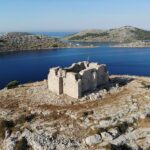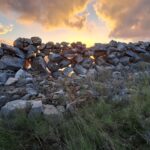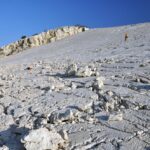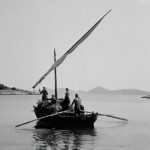Prepare to journey to one of Croatia’s most remarkable natural wonders – the Kornati Cliffs. These majestic cliffs, also known as crowns, rising over 80 meters above sea level and 90 meters into the sea depths, define the outer islands chain and are a unique feature of the Kornati archipelago. In this ultimate guide, we’ll take you on a tour of the origin of these breathtaking cliffs, explore the diverse flora and fauna that call the cliffs home, and reveal the best ways to experience their rugged beauty up close. From the iconic Klobučar Island to the hidden cliffs resembling human heads on Rašip Veliki Island, let’s discover the enchanting beauty of the Kornati Cliffs.
The Content
Exploring the Unique Cliffs of Kornati Archipelago
Scuba-diving beneath Kornati Cliffs
Deep Water Soloing on the Kornati Islands Cliffs
Tips to Accessing the Kornati Cliffs
Best Time to Approach Kornati Cliffs
The Origin of Kornati Cliffs
But what is the origin of these spectacular “crowns,” reaching over 80 meters above sea level and 90 meters into the sea depths? The answer lies in the earth’s interior and the enormous forces that arise from various processes. These breathtaking formations result from powerful geological forces that occur when the African tectonic plate moves under the Eurasian plate. The region, including Kornati, is known for being seismically active, causing the earth’s crust to wrinkle, erode, and thrust. The Kornati “crowns” are a unique feature created by this process.
Additionaly, the force of the sea waves relentlessly eroded the cliffs over time, creating a stunning display of natural beauty.
Exploring the Unique Cliffs of Kornati Archipelago
Nestled within the stunning Kornati archipelago, the captivating crowns majestically rise from the islands of Purara, Kasela, Klobučar, Lavsa, Mali and Veliki Škanj, Mala and Velika Panitula, Piškera, Veliki and Mali Rašip, Mana, Balun, Borovnik, Veliki and Mali Obručan.

The Kornati “crowns” are a natural wonder, each with unique features. Every cliff is distinct, and its appearance is subject to change with the varying amount of light and the time of day. As the sun moves across the sky, the interplay of light and shadow creates a constantly shifting canvas, revealing the intricate details of these majestic formations. Each moment is a unique opportunity to witness the ever-changing beauty of this remarkable landscape.
The crowns stretch approximately 7.5 kilometers, enchanting visitors with their rugged beauty and unique geological formation.
It is important to note that Islands Purara, Klobučar, Obručan Veli, and Obručan Mali have been designated zones of strict protection, ensuring their unspoiled beauty remains preserved for generations. To safeguard these fragile ecosystems, visitors are kindly asked to refrain from venturing into these strictly protected areas.
The Purara Island
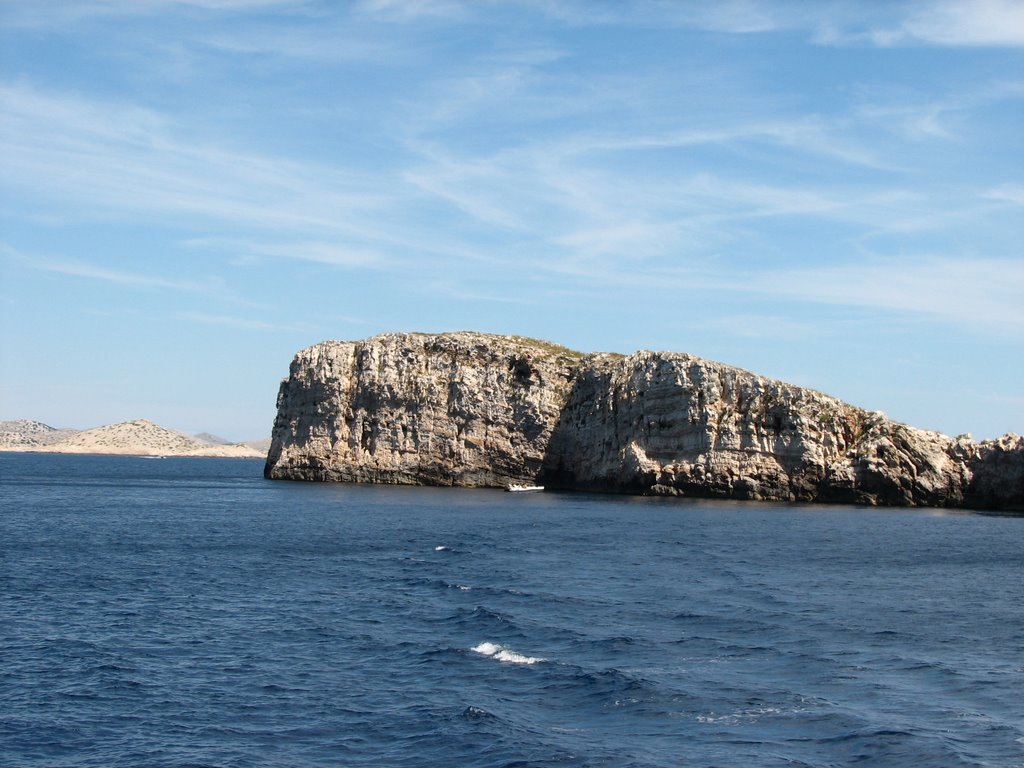
In the azure waters surrounding the Kornati Islands lies the island of Purara, with its rugged terrain and steep slopes rising from the southeast to the north. The water is shallow along the island’s northwest side, with the outside cut off by a towering rocky cliff that reaches 30 meters high. The island is also home to an endemic species of wild chard, thriving in this harsh landscape.
Purara Island is a protected ornithological reserve where approaching, docking, and landing are strictly prohibited.
The Klobučar Island
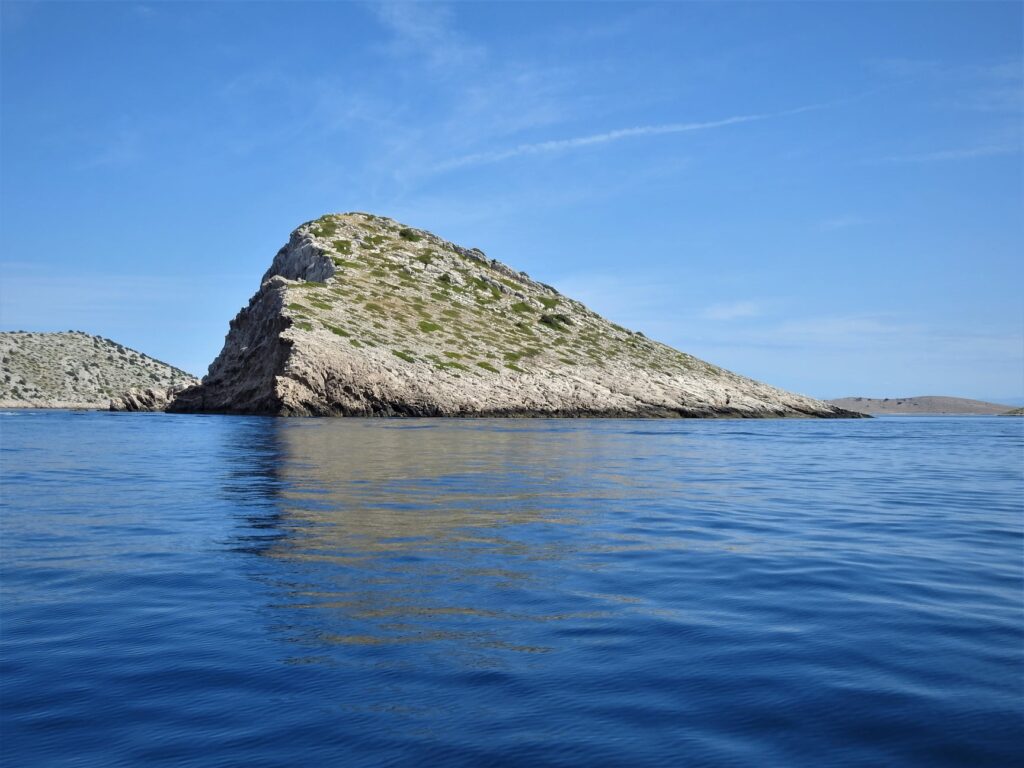
On the island of Klobučar, visitors to the Kornati archipelago can behold the highest of the famed “crowns,” rising 82 meters above sea level.
The majestic cliff of Klobučar Island is often the first encountered by tourists arriving by excursion boat, setting the stage for a breathtaking journey through the stunning landscape of the Kornati Islands.
The Panitula Vela Island
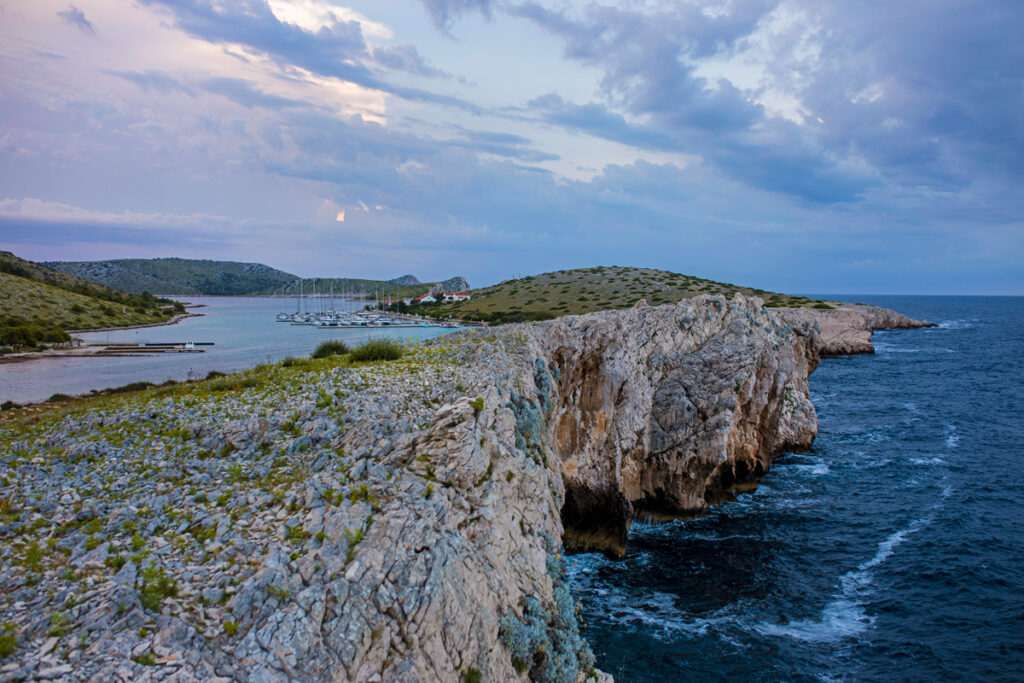
Vela Panitula Island boasts stunning natural beauty above and below the water’s surface. The only nautical marina in the Kornati National Park is located on the island of Vela Panitula.
Sailors fortunate enough to dock in the marina on Panitula Vela can venture to the edge of the cliffs, passing the remnants of a Venetian fortification from a 16th-century that offers a breathtaking vista of the open sea.
With crystal clear waters and abundant marine life, Vela Panitula is an unforgettable destination for any diving enthusiast seeking to discover the mesmerizing beauty of the Kornati archipelago.
Divers worldwide flock to this island, alongside Mana and Balun, to explore its underwater marvels, including a breathtaking underwater arch that is a favorite spot for photography enthusiasts.
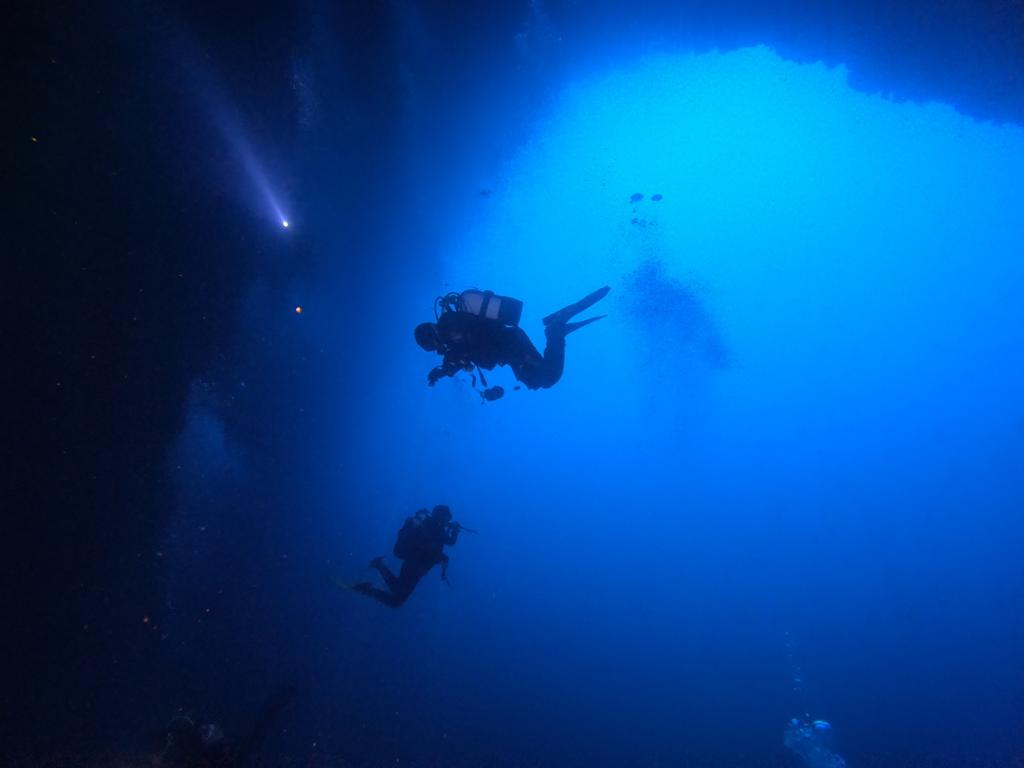
The Rašip Veliki Island
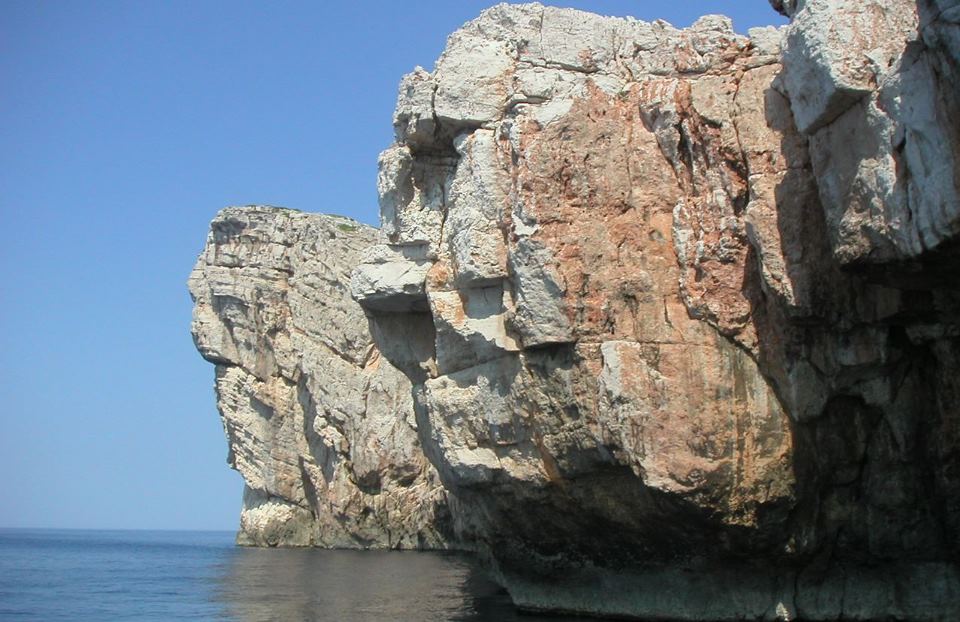
Cliffs on Islands Rašip Veliki and Mana are accessible through a small waterfront on its backside. These two islands are popular destinations for excursion boats.
Veliki Rašip, in particular, is renowned for its cliffs resembling human and even sphinx heads. The rock with the most recognizable human head is opposite the small waterfront on the back side of the island. A small path leads from the forefront to the island’s cliff, providing a thrilling experience for adventurous explorers.
The nearby settlements of Gujak and Vrulje bays offer convenient access points to Rašip Veliki Island, making it an unforgettable destination for those seeking the beauty and wonder of the Kornati archipelago.
The Mana Island
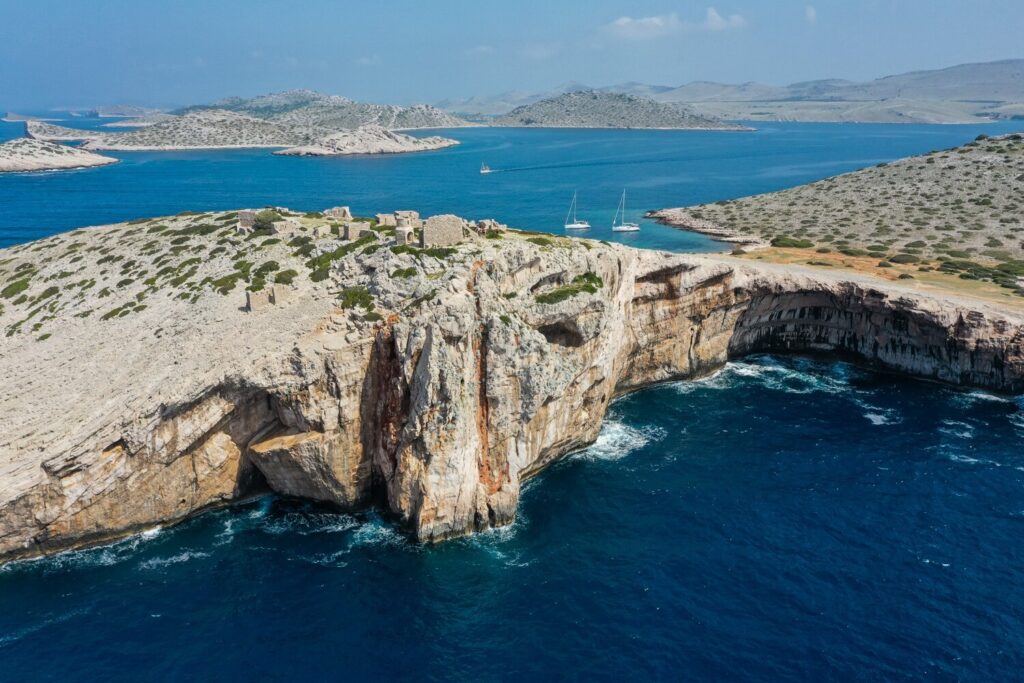
The island of Mana is a true natural wonder, boasting impressive geological formations and a rich cultural heritage.
One of the island’s most intriguing features is the movie village constructed on its peak for the film As The Sea Rages (1959). Here, visitors can explore the ruins of a dozen stone-built structures, including houses, storehouses, and a church, offering breathtaking views of the surrounding chain of islands.
Island Mana is accessible via a small waterfront on its northwest side.
Mana is privately owned. Visitors should treat the owner respectfully and avoid the crowds, which tend to be most significant between 11 a.m. and 3 p.m.
The nearby Strižnja, Kravljačica, and Bijela Lučica bays offer convenient access points to this mesmerizing island, making it an unforgettable destination for adventurous travelers.
The Obručan Veliki Island

The island of Obručan is a masterpiece of nature’s erosive power, which has shaped the magnificent Kornati Crowns into breathtaking works of art.
The island’s intriguing rock depressions and outcroppings are a testament to the elements’ raw power and ability to create stunning geological formations. As one venture through the Kornati archipelago, the island of Obručan stands out as a striking example of the transformative effects of time and nature.
Habitat for Many Species
The Kornati Cliffs, with their rugged beauty and unique geological formations, not only capture the hearts of travelers but also offer a sanctuary for various bird species and endemic plants. The “crowns” of the Kornati Islands provide a perfect habitat for many bird species, including Yellow-legged Seagulls, European shags, and wild pigeons. These majestic cliffs serve as a nesting ground for many birds, and their steep slopes provide protection from predators.
Aside from the rich birdlife, the Kornati Cliffs are also home to some of the endemic plant species found in the region, such as Dubrovačka zečina (Centaurea ragusina. L.). This unique plant species thrive in the Kornati Islands’ harsh environment, showcasing the local flora’s adaptability and resilience.
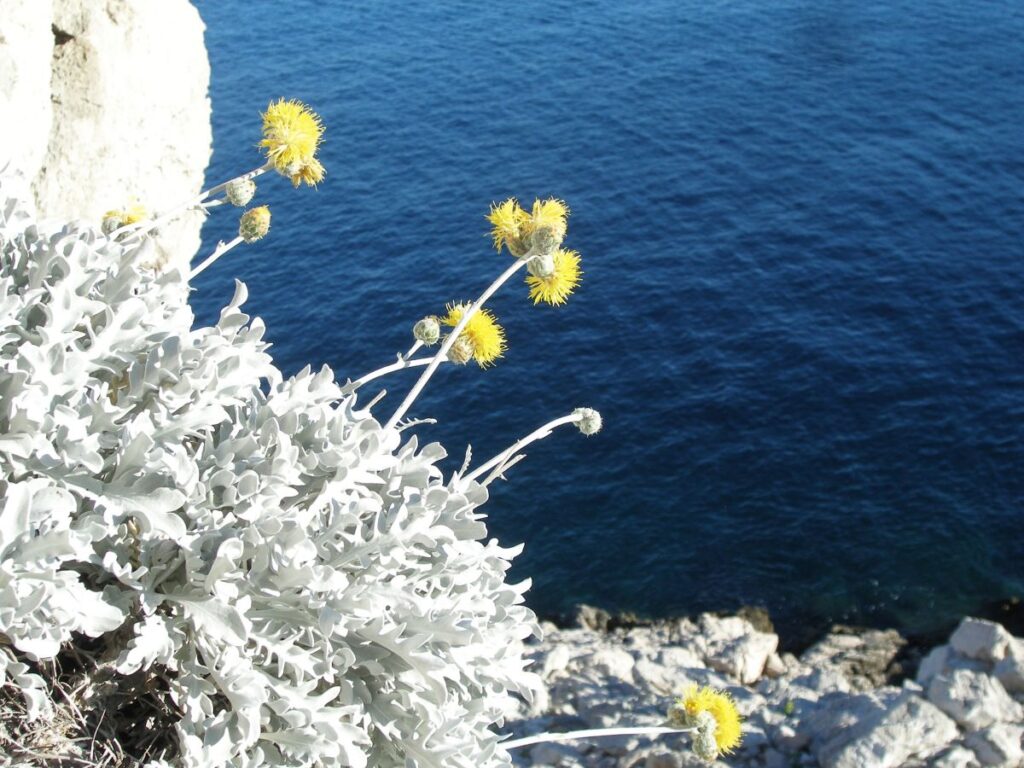
Hidden beneath the depths of the majestic Kornati Cliffs lies a fascinating ecosystem known as the coraligenic habitat. This unique habitat, located on the cliffs’ open-sea slopes, is formed by red algae that absorb limestone from the surrounding seawater, incorporating it into their bodies.

Despite the low light conditions of this underwater world, an array of marine species thrive within it. From the intricate sponges to the vibrant corals, moss animals, and red and brown algae, the coraligenic habitat is teeming with life.
Scuba-diving beneath Kornati Cliffs
The deep waters under the Kornati Cliffs are a magnet for scuba diving enthusiasts.
So much so, that six out of the nine official diving zones of the Kornati National Park are located beneath these majestic cliffs.
The diving zones that lie under the cliffs are Mala Panitula, Vela Panitula, Rašip, Kasela, Mana, and Borovnik. With its rich marine life and stunning underwater topography, diving in the Kornati Cliffs is an unforgettable experience for both amateur and experienced divers alike.
Deep Water Soloing on the Kornati Cliffs?
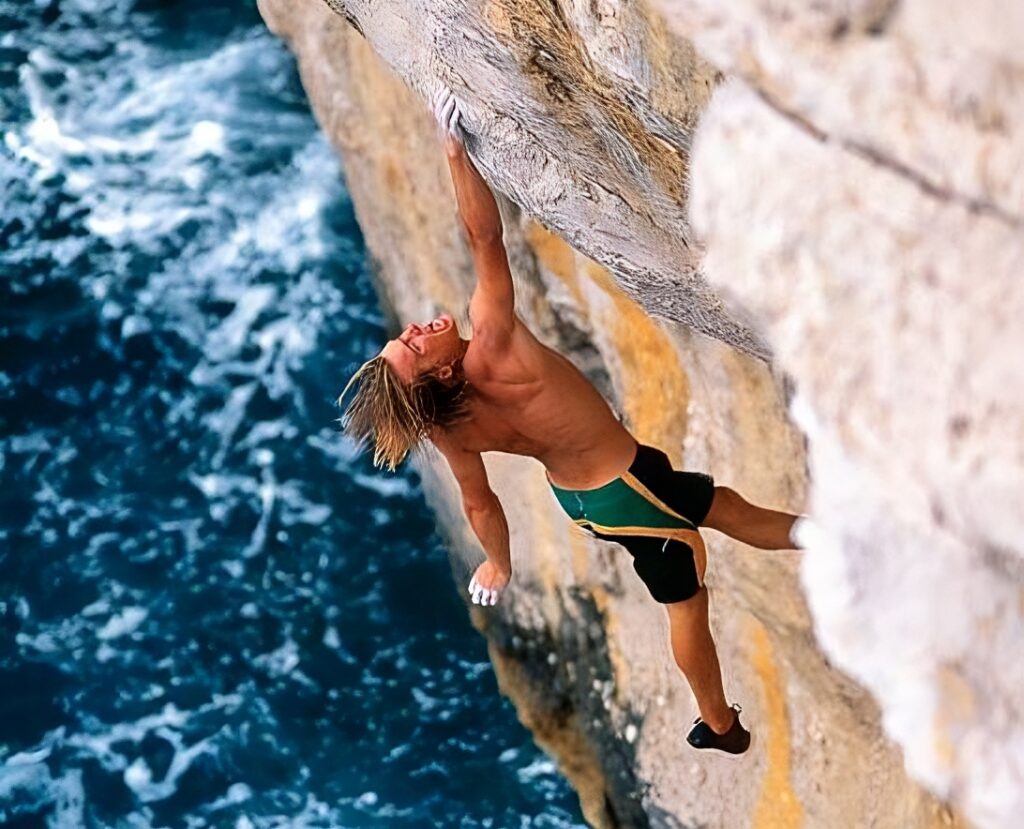
Deep water soloing (DWS) is a thrilling rock climbing style requiring no protective equipment. Climbers scale natural rock formations above deep water, plunging into the water below if they fall.
While the sport has become increasingly popular, DWS is strictly prohibited in the Kornati Islands due to its sensitive ecosystem.
Tips to Accessing the Kornati Cliffs
The Kornati National Park can only be accessed by boat, with the primary departure point in Murter, 10-20 nautical miles away.
Tourist Excurison Boats
Tourist excursion boats passing under the majestic Kornati cliffs are popular, with Tureta Boats stopping on Mana and Račić motorboat on Veli Rašip. Smaller boats provide a personalized experience.
Kayaking&Paddleboarding
Exploring the Kornati cliffs by kayak or paddleboard is a thrilling experience, but caution must be taken due to regulations in Croatia. Since it is forbidden to kayak on the open sea, it is advised to transport kayaks to Kornati Islands with a larger boat or to use kayaks offered by Kornati Islands Accommodations. Similarly, it is recommended to transport SUP with a ship near cliffs and use it only during calm weather. These measures ensure a safe and unforgettable experience, allowing visitors to witness the raw beauty of the Kornati cliffs up close.
Other means
Besides the excursion boats, numerous other options exist for sailing to the Kornati islands: from sailing with your vessel to utilizing rent-a-boat agencies or transfer services offered by Kornati accommodation owners. Additionally, some accommodations on the Kornati islands provide the option of renting small motorboats, allowing visitors to explore the islands and surrounding waters at their own pace. This convenient and accessible mode of transportation offers a personalized experience, making it even easier for travelers to discover the beauty and allure of the Kornati archipelago.
The closest bays for exploration of the most stunning cliffs, such as Veli Rašip, Mana, and Obručan Veliki, are Gujak, Vrulje, Strižnja, and Bijela Lučica. Ports in the south of Kornat Island and the islands of Lavsa and Piškera are suitable for exploring the cliffs of the isles of Klobučar, Lavsa, Panitula, and Piškera. Ports on the north side of Kornat Island can also be the base for exploring the Great White Cliffs of Dugi Otok Island.
Although the cliff islands seem inaccessible from the sea, some, such as Rašip Veliki and Mana, can be accessed through small waterfronts on their backside. These hidden pathways provide adventurous visitors with a unique perspective on the islands and an opportunity to explore the rugged terrain by hiking. It’s a chance to witness the raw power of nature up close and experience the awe-inspiring beauty of these islands.
Best time to approach Kornati Cliffs
Venturing to the Kornati archipelago is a breathtaking experience best savored during the serene months of late spring and early autumn. During these seasons, the sultry heat of the high season (July and August) gives way to more comfortable temperatures, allowing explorers to immerse themselves in the islands’ natural wonders fully. Additionally, as the crowds of summer visitors dwindle, the tranquil atmosphere of the Kornati islands is further enhanced, presenting an idyllic setting for adventurers seeking a truly immersive and unforgettable experience.
Approaching cliffs closely by boat is a thrilling and awe-inspiring experience. However, it is crucial to consider the weather conditions to ensure a safe and enjoyable journey. The unpredictable and ever-changing nature of the sea demands a certain level of caution and respect for its power.
Experienced sailors and adventurers know that the best time to approach the cliffs is during calm weather, allowing for a closer and more intimate encounter with these magnificent natural wonders.
As our journey through the majestic Kornati Cliffs ends, we are left with profound awe and appreciation for the natural beauty and geological wonders that define this enchanting archipelago. From the soaring crowns that stretch across the skyline to the vibrant and thriving ecosystems hidden beneath the surface, these cliffs stand as a testament to the earth’s transformative power and the resilience of the flora and fauna that call this region home.
Whether you experience the Kornati Cliffs by sailing, scuba diving, or navigating the rugged terrain on foot, you’ll be captivated by their breathtaking allure and the untamed beauty that resonates throughout the islands. As you venture forth and explore these remarkable landscapes, remember to respect the delicate balance of nature and the efforts taken to preserve these wonders for generations to come. May your journey through the Kornati archipelago leave you with a renewed sense of wonder and a deeper appreciation for the world’s awe-inspiring natural splendors.
